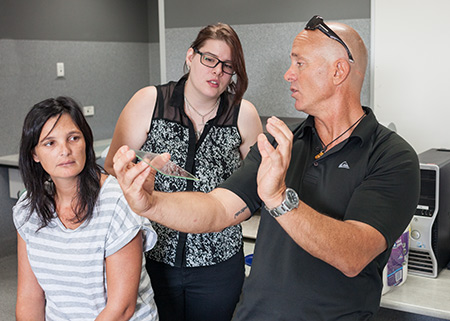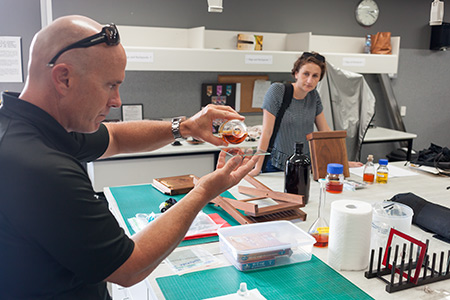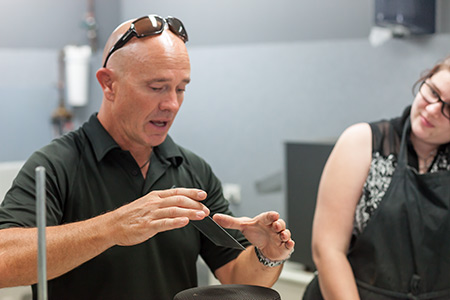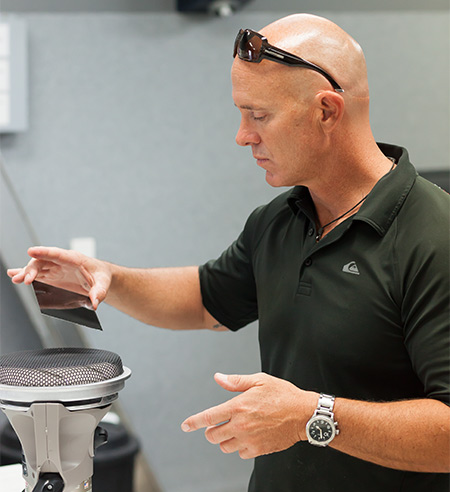Marking time in March 2015
Doing wet plate photography
To go with the exhibition The view from here the Museum of Brisbane put on a one-day workshop on the wet-plate (collodion) photographic process last Saturday. The workshop was taught by photographer Craig Tuffin and organised by Hilary Perrett from the museum. It was limited to three participants and I was one of them. The other two were photography students at the Queensland College of Art where the workshop was held. There we had the use of well-equipped and well-ventilated darkrooms.

Craig Tuffin is a fine art photographer who incorporates nineteenth-century processes in his practice—processes that he has mastered through study and experiment. The two other workshop participants were interested in the creative use of these processes. I don’t aspire to make such work—for me the workshop was a chance to understand the practicalities that my second great grand uncle Daniel Marquis dealt with.

Daniel Marquis was a commercial photographer in Scotland from the early 1850s, came to Brisbane in 1865, and operated a studio here until his death in 1879. The collodion (wet plate) process was the predominant photographic process throughout his photographic career. Skilled operators like Daniel could make excellent photographs with collodion but, as I was to find out, there were many technical difficulties.

The simplest application of the collodion process was the tintype, a photographic image made on a sheet of tinplate coated with black japan (a kind of bituminous lacquer). Each tintype photograph is a unique artefact produced by exposure to light in the camera, rather than one of any number of prints made from a negative.
With Craig’s guidance we each produced several tintype photos, by coating, sensitizing, exposing, developing, and varnishing a metal plate. Instead of japanned tinplate we used sheets of aluminium with a modern paint finish, but in other respects the materials and methods would have been familiar to Daniel Marquis. Here is an outline of the steps we followed.
Setting up the camera—Craig brought along various large-format cameras. I chose to use his 4x5 inch Sinar which brought back memories of working with similar gear.
Coating—This step involves holding the plate horizontal and pouring collodion on to it, tipping the plate slightly so that the sticky fluid coats it evenly. Easier said than done.
Sensitizing—Under dim red light, the still-damp plate is placed into a bath of silver nitrate for three to four minutes, taken out and dried on its back and edges, then inserted into the light-proof plate holder.
Exposing—Quickly, while the emulsion is still damp, the plate holder is placed in the camera (which has already been set up and focussed), the dark slide withdrawn, and the camera shutter opened to expose the plate to light. Judging the exposure, given the uncontrolled variables, seems to be a black art.
Developing—Quickly, before the collodion emulsion dries, the dark slide is refitted, and the plate holder is taken back to the darkroom for processing. The developer is poured onto the plate (evenly, not too slow, not too fast, not too vigorously…) and gently shaken while the development proceeds under the red light for about fifteen seconds. When it is judged that the time is right (another black art) the development is stopped with water, and the plate is rinsed with several changes of water, then fixed in hypo for five minutes, then put into a hypo-clearing tray, and then washed for thirty minutes and allowed to dry.
Varnishing—To protect the fragile emulsion from physical and atmospheric damage it is coated with varnish. First the plate is warmed, then an even coating of gum sandarac varnish is deftly poured on it. It take practice to achieve deftness.

At the end of the day I was pleased to have made three tintypes with recognisable images on them. If I were to set up a darkroom and work on my skills I’m sure I could make some decent wet plate photographs, but I don’t intend to do that. It was enough for me to have a day’s exposure to some of the realities of nineteenth-century photography. It took me a step beyond what I had got from books.
